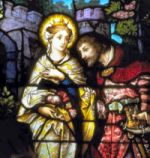Make your gift today!
Help keep Catholics around the world educated and informed.
Already donated? Log in to stop seeing these donation pop-ups.
Catholic Activity: Holy Saturday with the Slovaks
Here Ann Michna describes some Slovakian customs associated with Holy Saturday, including traditional dishes, a special food blessing, and an Easter eve procession.
DIRECTIONS
As on the day before Christmas, so also on the day before Easter, Holy Saturday, every Slovak household is a beehive of activity. The lady of the house again bakes Kolace or Slovak pastry, and a special bread eaten only at this festive season, called the Paska. This again is not a Slovak word. It is from the Greek Pascha, and the Hebrew Pesah, meaning "Passover." This bread is probably in some way connected with the unleavened bread used in the ancient Jewish custom of celebrating their great and most joyous feast, the feast of the Pasch, commemorating the great national event of Israel's departure from Egypt, and at the same time making the beginning of the harvest.
Other foods which are prepared for this occasion are Klobasy. which are beef and pork sausages, and smoked ham. Eggs are died in red beet juice, and in colored water obtained by boiling onion skins. The eggs are decorated artistically with Batik work, using wax with a pin point to mark out the intricate patterns. Sirek is made of eggs and other ingredients, and pressed like cheese. Horeseradish is ground and mixed with boiled, grated red beets. Eggs are boiled separately to be eaten with the ham.
In the afternoon, when the food has been prepared for the next day, the lady of the house places a colorfully woven basket on the table. Into it she puts some lamb meat, signifying the Lamb of God, a small piece of home smoked and home cured bacon, ham, klobasy, boiled eggs, dyed and plain, the Sirek, the Paska, some kolace, some horseradish, and a little salt. The basket is then covered with a white linen embroidered cloth, and taken to the church where the priest blesses it, using this prayer:
"Bless, O Lord, this creation that it may be a means of salvation to the human race, and grant that, by the invocation of Thy Holy Name, it may promote health of body, and salvation of soul in those who partake of it, through Christ our Lord." This food is then taken home, and eaten as breakfast Easter Sunday, Monday and Tuesday.
Holy Saturday night, in all Slovak churches, there are very impressive and joyful ceremonies, called the Resurrection Services. These consist of a solemn procession around the aisles of the church, in which the priest, altar boys, flower girls, and young men and women take part. The procession is led by a man carrying a statue of the Risen Christ, followed by men carrying the paschal and triple candles.
The processioin is started by the priest intoning the hymn, "Jesus Christ is risen from the dead!" With the joyous ringing of bells, and the triumphant sounding forth of the church organ, the congregation takes up the hymn, and sings it throughout the whole procession.
On Easter Sunday, instead of the usual salutation, "Praised be Jesus Christ," it is "Jesus Christ is risen from the dead," repeated three times. And the answer, also repeated three times, is "Indeed He has risen."
Activity Source: Your Home, A Church in Miniature by Compiled by The Family Life Bureau in the early 1950s, The Neumann Press, Long Prairie, Minnesota, 1994






